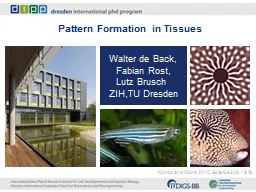

Walter de Back Fabian Rost Lutz Brusch ZIHTU Dresden Kondo and Miura 2010 Science 329 1616 Aims Translation of the sketch of a mechanism into a mathematical model Characterisation of pattern forming ID: 1000144
Download Presentation The PPT/PDF document "Pattern Formation in Tissues" is the property of its rightful owner. Permission is granted to download and print the materials on this web site for personal, non-commercial use only, and to display it on your personal computer provided you do not modify the materials and that you retain all copyright notices contained in the materials. By downloading content from our website, you accept the terms of this agreement.
1. Pattern Formation in TissuesWalter de Back,Fabian Rost,Lutz Brusch ZIH,TU DresdenKondo and Miura 2010, Science 329, 1616.
2. AimsTranslation of the sketch of a mechanism into a mathematical modelCharacterisation of pattern forming processesUnderstand theory papersOwn models in Morpheus simulation framework Methods encountered during the week:Reaction-diffusion models, Cellular Potts modelsRole of initial state and of parameter settings for pattern formation Planning, performing and analysing model simulationsHands-on LinuxKeep electronic protocol, notes, figuresAgenda
3. Agenda MondayTuesdayWednesdayThursdayFriday0 1 2 3 4 5 Mo Module 0: Introduction (Lutz) Mo Module 1: Modeling workflow (Fabian) Tue Module 2: Morphogen gradients + Literature study (Lutz) Wed Module 3: Model comparison: Vascular patterning (Walter)Thu Module 4: Model refinement: Morphodynamics (Fabian&Walter)Fri Module 5: Top-down modeling, project examples, summary (Lutz)
4. ModelsTest hypothesis, counter-intuitive behaviorInfer hidden propertiesHuman -> model organism -> conceptual model -> mathematical model -> model implementationBottom-up vs. top-down models
5. Top-down model: SomitogenesisHerrgen et al., Current Biology, 20, 1244-1253 (2010)
6. Top-down model: SomitogenesisHerrgen et al., Current Biology, 20, 1244-1253 (2010)
7. Top-down model: SomitogenesisHerrgen et al., Current Biology, 20, 1244-1253 (2010)
8. Interdisciplinary workflow
9. Different model types for cell mechanics
10. Central questionsHow is a complex pattern encoded in the genome?How can a pattern evolve?Kondo and Miura 2010, Science 329, 1616.
11. Central questionsHow is a complex pattern encoded in the genome?How can a pattern evolve?Kondo and Miura 2010, Science 329, 1616.
12. Central questionsHow is a complex pattern encoded in the genome?How can a pattern evolve?Prepattern vs. self-organisationRoots in physics, chemistryMathematical theoryApplications to BiologyKondo and Miura 2010, Science 329, 1616.
13. Pattern formation from pre-pattern
14. Self-organising pattern formationRoots in physicsSecond law of thermodynamics: all isolated systems approach a state of maximum disorder.
15. Experimentstarting from homogeneous solution
16. Roots in physicsSecond law of thermodynamics: all isolated systems approach a state of maximum disorder.Erwin Schrödinger, 1944: What Is Life? Open systems increase and maintain order at expense of disorder in their environment.Flux of energy and material through living system.
17. Belousov-Zhabotinsky reaction
18. 1951 - Boris P. Belousov discovers oscillatory reaction but cannot publish his data1961 - Anatoly Zhabotinsky re-discovers recipe and observes travelling waves, spirals1977 - Nobel Prize in Chemistry to Ilya Prigogine "for his contributions to non-equilibrium thermodynamics, particularly the theory of dissipative structures“ “self-organisation of complex patterns in simple systems”Roots in chemistry
19. Def.: 3 classes of self-organising patternsSteady state pattern: fixed non-homogeneous distribution of cell types or molecule concentrations as function of spatial position Yet, this is no equilibrium: energy and matter circulate in and out of the system.Rhythm: ordered, homogeneous temporal signal, e.g. electrocardiogram, circadian rhythm Coherent structure: ordered, propagating wave or pulse, e.g. action potential travelling along axonxtx-vt
20. Alan Turing60th anniversaryRoots in mathematics
21. Diffusion alone smoothens
22. Alan Turing (1952)
23. Gierer-Meinhardt principle: local activation, lateral inhibitionGierer, A. and Meinhardt, H. (1972). A theory of biological pattern formation. Kybernetik 12, 30-39.
24. Hobmayer et al. 2000Meinhardt 1982
25. Patterns in other areas, same principleSand dunesErosionSettlements
26. Vorname Name
27. Simulations reproduce complex shell and fish patternsKondo and Miura 2010, Science 329, 1616.
28. Pattern hybridizationMiyazawa et al., Nature Comm.1, 66white spots + dark spots = ?
29. Pattern hybridizationMiyazawa et al., Nature Comm.1, 66white spots + dark spots = labyrinth
30. Miyazawa et al., Nature Comm.1, 66Pattern hybridization
31. Central questionsHow is a complex pattern encoded in the genome?How can a pattern evolve?Kondo and Miura 2010, Science 329, 1616.
32. LiteratureA. Turing (1952) The Chemical Basis of Morphogenesis. Phil. Trans. R. Soc. Lond. B 237, 37-72.A. Gierer and H. Meinhardt (1972) A theory of biological pattern formation. Kybernetik 12, 30-39.H. Meinhardt (1982) Models of Biological Pattern Formation. Academic Press and http://www.eb.tuebingen.mpg.de/de/forschung/emeriti/hans-meinhardt/home.htmlJ. D. Murray (2007, 3rd ed.) Mathematical Biology. SpringerS. Kondo and T. Miura (2010) Reaction-Diffusion Models as a Framework for Understanding Biological Pattern Formation. Science 329, 1616-1620.